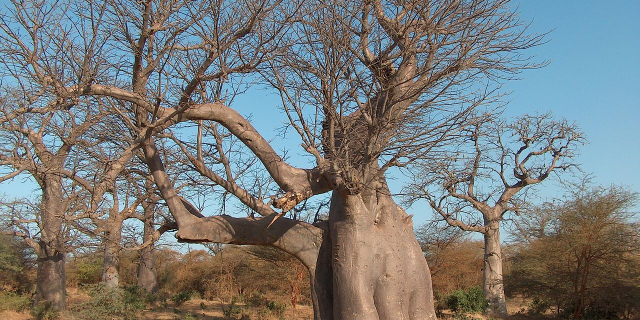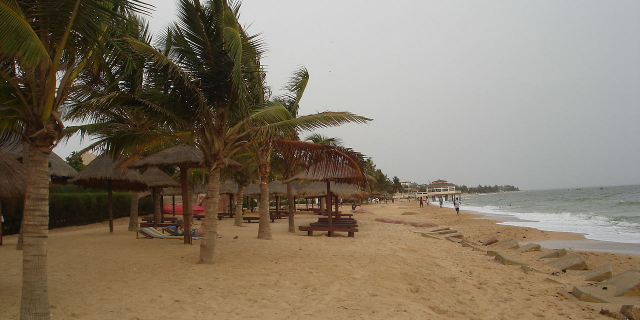Saint-Louis, Senegal
Saint Louis or Saint-Louis (Wolof: Ndar), is the capital of Senegal's Saint-Louis Region. Located in the northwest of Senegal, near the mouth of the Senegal River, and 320 kilometres (200 mi) north of Senegal's capital city Dakar, it has a population officially estimated at 258,592 in 2021. Saint-Louis was the capital of the French colony of Senegal from 1673 until 1902 and French West Africa from 1895 until 1902, when the capital was moved to Dakar. From 1920 to 1957, it also served as the capital of the neighboring colony of Mauritania.
The town was an important economic center during French West Africa, but it is less important now. However it still has important industries, including tourism, a commercial center, a center of sugar production, and fishing. The tourism industry is in part due to the city being listed as a UNESCO World Heritage Site in 2000. However, the city is also vulnerable to climate change—wh...Read more
Saint Louis or Saint-Louis (Wolof: Ndar), is the capital of Senegal's Saint-Louis Region. Located in the northwest of Senegal, near the mouth of the Senegal River, and 320 kilometres (200 mi) north of Senegal's capital city Dakar, it has a population officially estimated at 258,592 in 2021. Saint-Louis was the capital of the French colony of Senegal from 1673 until 1902 and French West Africa from 1895 until 1902, when the capital was moved to Dakar. From 1920 to 1957, it also served as the capital of the neighboring colony of Mauritania.
The town was an important economic center during French West Africa, but it is less important now. However it still has important industries, including tourism, a commercial center, a center of sugar production, and fishing. The tourism industry is in part due to the city being listed as a UNESCO World Heritage Site in 2000. However, the city is also vulnerable to climate change—where sea level rise is expected to threaten the city center and potential damage historical parts of the city. Moreover, other issues such as overfishing are causing ripple effects in the local economy.
 Negresse of quality from the Island of Saint Louis in Senegal, accompanied by her slave, Illustration from Costumes civils de tous les peuples connus, Paris, 1788, by Jacques Grasset de Saint-Sauveur.
Negresse of quality from the Island of Saint Louis in Senegal, accompanied by her slave, Illustration from Costumes civils de tous les peuples connus, Paris, 1788, by Jacques Grasset de Saint-Sauveur.A Wolof settlement at what is now known as Guet Ndar dates from around 1450 and was a meeting and departure point for Muslim pilgrims traveling to Mecca in Arabia.[1] Portuguese, Dutch, and English traders visited the area over the next two centuries but the first nearby colonial fortification was erected by the French in 1638 on Bocos Island, about 25 km (16 mi) away.[2]
Repeated flooding prompted the removal of the fort to the island known to locals as Ndar in 1659.[2] The island was uninhabited at the time,[3] supposedly because the local people believed it to be haunted by spirits.[2] The Diagne of Sor, the local leader, permitted French settlement on the island for annual payments of "three pieces of blue cloth, a measure of scarlet cloth, seven long iron bars, and 10 pints of eau de vie."[2]
 French view of the fort at Saint-Louis island, from "L'Afrique ou histoire, moeurs, usages et coutumes des Africains", by René Claude Geoffroy de Villeneuve, 1814.Colonial Capital
French view of the fort at Saint-Louis island, from "L'Afrique ou histoire, moeurs, usages et coutumes des Africains", by René Claude Geoffroy de Villeneuve, 1814.Colonial Capital
The fortification permitted its factory to command foreign trade along the Senegal River. Slaves, gold, hides, beeswax, ambergris and, later, gum arabic were exported. During the Seven Years' War, British forces captured Senegal in 1758. In February 1779, French forces recaptured Saint-Louis. In the late 18th century, Saint-Louis had about 5,000 inhabitants, not counting an indeterminate number of slaves in transit.
 Colonial Saint Louis c. 1900. Europeans and Africans on the Rue Lebon.
Colonial Saint Louis c. 1900. Europeans and Africans on the Rue Lebon.Between 1659 and 1779, nine chartered companies succeeded one another in administering Saint-Louis. As in Gorée, a Franco-African Creole, or Métis, merchant community characterized by the famous "signares", or bourgeois women entrepreneurs, grew up in Saint-Louis during the 17th and 18th centuries. The Métis were important to the economic, social, cultural and political life of the city. They created a distinctive urban culture characterized by public displays of elegance, refined entertainment and popular festivities. They controlled most of the up-country river trade and they financed the principal Catholic institutions. A Métis mayor was first designated by the Governor in 1778. Civic franchise was further consolidated in 1872, when Saint-Louis became a French "commune".
After the decline of the Atlantic slave trade after 1790, the trade in gum arabic replaced it as the major economic engine of Saint Louis. Trade was increasingly concentrated in the lower river valley and the desert-side escales, rather than further upriver in Gajaaga as it had been previously. The city was again captured by the British during the Napoleonic Wars, and returned to France in 1817. Facing a near-total dependence on gum, the French authorities tried to promote plantation agriculture in Waalo from 1819-1830, but this failed. At the same time, Saint Louis grew massively during this period in both population in commercial activity.[4]: 115–6
Throughout the 19th century, the French periodically warred with the Emirate of Trarza and other Hassani tribal states, which disrupted the flow of gum. Nevertheless, with the removal of trade restrictions in 1848 and in 1853, exports soared. When war again broke out in 1854, the Arab Emirs forbade the Berber zwaya merchants from selling to the French, but this had little effect.[4]: 130 In the 1855 Battle of Leybar Bridge a small force of French Marines defended the town from a large Trarza force. With the French victory in 1858, they were able to set the terms of trade on the river.[4]: 130
Louis Faidherbe, who became the Governor of the Colony of Senegal in 1854, contributed greatly to the development and modernization of Saint Louis. His large-scale projects included the building of bridges, provisioning of fresh drinking water, and the construction of an overland telegraph line to Dakar.[5] Saint-Louis became capital of the federation of French West African colonies in 1895, but relinquished this role to Dakar in 1902.
 Faidherbe Bridge, the symbol of the city.
Faidherbe Bridge, the symbol of the city.Saint-Louis's fortunes began to wane as those of Dakar waxed. Access to its port became increasingly awkward in the age of the steamship and the completion of the Dakar-Saint Louis railroad in 1885 meant that up-country trade effectively circumvented its port. Large French firms, many from the city of Bordeaux, took over the new commercial networks of the interior, marginalizing the Métis traders in the process. Saint-Louis nonetheless maintained its status as capital of the Colony of Senegal even after Dakar assumed the role of capital of the French West Africa federation. The colonial institutions set up in the city in the 19th century, such as the Muslim Tribunal and the School for Chiefs' Sons, were to play important roles in the history of French Africa. Though relatively small in size (population of 10,000 in 1826; 23,000 in 1914, and 39,000 in 1955) Saint-Louis dominated Senegalese politics throughout the 19th and early 20th centuries, not least because of its numerous political parties and associations and its independent newspapers.[citation needed]
IndependenceFollowing independence, when Dakar became sole capital of the country, Saint-Louis slipped into a state of lethargy. As its French population and military departed, many of the town's shops, offices and businesses closed.[6] The loss of jobs, human potential, and investment caused its economic decline. The loss of its past status meant less recognition and lack of interest from the colony's officials and, after Senegal's independence, from the Senegalese government. When its most famous political son, the French-educated lawyer Lamine Guèye, died in 1968, the city lost its strongest proponent.
Since 1993, the city has hosted the Saint Louis Jazz Festival, a major tourist draw.[7]





























Add new comment